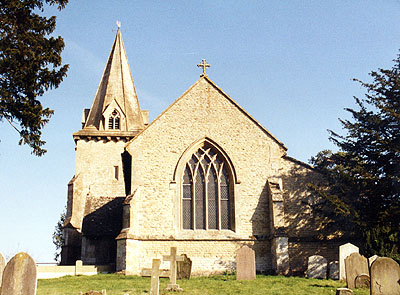 |
 |
|||
|
|
Explore
the churchyard, before entering here. Robert Lindsey’s effigy with art
nouveau weeping children is unusual for an external monument, but it seems
to be holding up well. Other members of Lord
Wantage’s family have interesting gravestones nearby, and there
are some with bronze inlay. The churchyard cross is 14th century, although
the topmost cross has been replaced. You enter the church next to the tower
with its stumpy spire. This latter is a Victorian addition to a mainly 13th
century building. In the porch is some interesting 13th century stone
carving: a king’s head between human-faced serpents under a canopy. Was it
part of an early monument, or perhaps a font? It must have been extremely
fine when complete. The main doorway has Norman dogtoothing, whilst the
south doorway, now glazed with engraved glass, has good ballflower
decoration. Inside, the kneeling
lady at the west end of the nave immediately draws one’s eye. She is a
very elegant example of Greek revival sculpture, dedicated to Robert
Vernon’s wife (1848) from Ardington House. On one side of her is the
medieval font with tall figured modern cover. On the other, Edward
Clarke’s large (and recently moved) pedimental wall monument
(1630) with angels pulling back curtains to reveal the columned
inscription. The contrasting black with white and gold make it a
surprisingly pleasing ensemble. It was originally in the southern Clarke
Chapel, now a vestry. This has an unusual trefoil-headed squint through
which to see the altar. The Clarkes were at Ardington House for centuries,
but they have only one other small plaque and a hatchment in the church. The
Vernons have more plaques, as well as a neo-classical bust within a superbly
carved gothic revival stonework frame hidden away beneath the tower: a
strange combination which only the Victorians could get away with. The
northern Vernon chapel (another vestry), also hidden away, has some nice
Gothic revival glass and delightful heraldic Vernon floor tiles. The Greek
lady originally knelt here. The Stuart pulpit has a rather good Victorian
sounding board and the walls are adorned with well carved medieval corbels,
including a pelican and a man with toothache (?!). This is not the official Ardington Church website. Please do NOT mail me about use of the church. Visit the C of E's Church Near You website instead.
|
|||
| © Nash Ford Publishing 2010. All Rights Reserved. The location of this church is now administered by Oxfordshire County Council. | ||||



 Ardington
Ardington